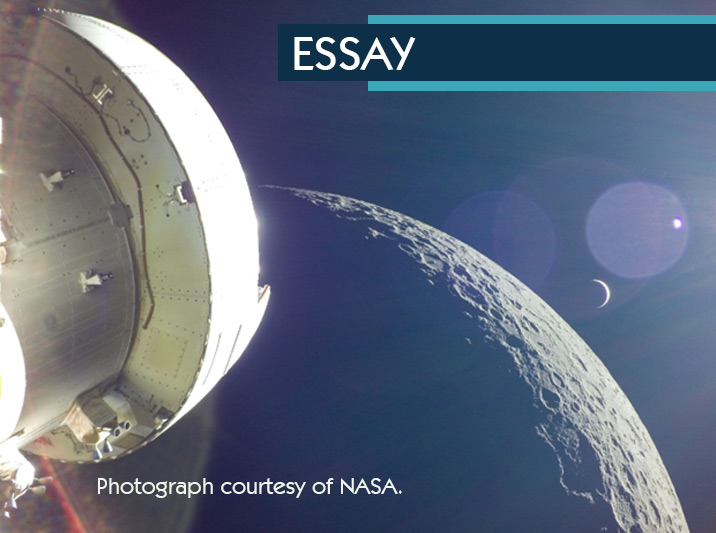Story Details

This article, the draft of which was written days after the Artemis I flight, gives an idea of the amount of work that went into the entire Artemis I mission by focusing on the work of one team: the trajectory design team, responsible for creating the path the spacecraft would take from the Earth to the Moon and back again. Robert Harpold takes us behind the scenes where, after so many years, we’ve sent a human-rated spacecraft back to the Moon!
Author Details
Robert E. Harpold Flybys, Launch Windows, and Selfies with the Earth and Moon: The Artemis I Flight from the Perspective of a Member of the Trajectory-Design Team
Robert E. Harpold is an engineer working for ERC, Inc., a subcontractor for NASA, designing trajectories for the Artemis missions. In his previous jobs, he has operated a weather satellite and a space-weather spacecraft for NOAA and, for a different NASA project, has flown over Greenland and Antarctica to collect data on their elevation changes. He is married to his amazing and accomplished wife Julie and has a young and very smart daughter named Isabelle. ABOUT FLYBYS, LAUNCH WINDOWS, AND SELFIES WITH THE EARTH AND THE MOON: THE ARTEMIS I FLIGHT FROM THE PERSPECTIVE OF A MEMBER OF THE TRACJECTORY-DESIGN TEAM This article, the draft of which was written days after the Artemis I flight, will hopefully give an idea of the amount of work that went into the entire Artemis I mission by focusing on the work of one team. It’s easy to just say that we designed the trajectories for the Artemis flights, but I think that by showing all the pieces that go into those trajectories, readers can extrapolate the magnitude of the undertaking for all the teams involved and the level of detail they all needed for their individual subsystems. I also shared some personal experiences to give the human side of what was happening. I hope readers take away how exciting it was to work on this flight and that the article gives hope for the future by showing what humans can achieve when we work together to explore and push our limits. As a side benefit, since one of DreamForge’s focuses is developing writers, I’m hoping that seeing some of the details of an engineering project like this and seeing what it’s like to work on this project will help authors add more realism when they write about similar subjects.
Flybys, Launch Windows, and Selfies with the Earth and Moon: The Artemis I Flight, by Robert Harpold
Author Details
Robert E. Harpold Flybys, Launch Windows, and Selfies with the Earth and Moon: The Artemis I Flight from the Perspective of a Member of the Trajectory-Design Team
Robert E. Harpold is an engineer working for ERC, Inc., a subcontractor for NASA, designing trajectories for the Artemis missions. In his previous jobs, he has operated a weather satellite and a space-weather spacecraft for NOAA and, for a different NASA project, has flown over Greenland and Antarctica to collect data on their elevation changes. He is married to his amazing and accomplished wife Julie and has a young and very smart daughter named Isabelle. ABOUT FLYBYS, LAUNCH WINDOWS, AND SELFIES WITH THE EARTH AND THE MOON: THE ARTEMIS I FLIGHT FROM THE PERSPECTIVE OF A MEMBER OF THE TRACJECTORY-DESIGN TEAM This article, the draft of which was written days after the Artemis I flight, will hopefully give an idea of the amount of work that went into the entire Artemis I mission by focusing on the work of one team. It’s easy to just say that we designed the trajectories for the Artemis flights, but I think that by showing all the pieces that go into those trajectories, readers can extrapolate the magnitude of the undertaking for all the teams involved and the level of detail they all needed for their individual subsystems. I also shared some personal experiences to give the human side of what was happening. I hope readers take away how exciting it was to work on this flight and that the article gives hope for the future by showing what humans can achieve when we work together to explore and push our limits. As a side benefit, since one of DreamForge’s focuses is developing writers, I’m hoping that seeing some of the details of an engineering project like this and seeing what it’s like to work on this project will help authors add more realism when they write about similar subjects.
